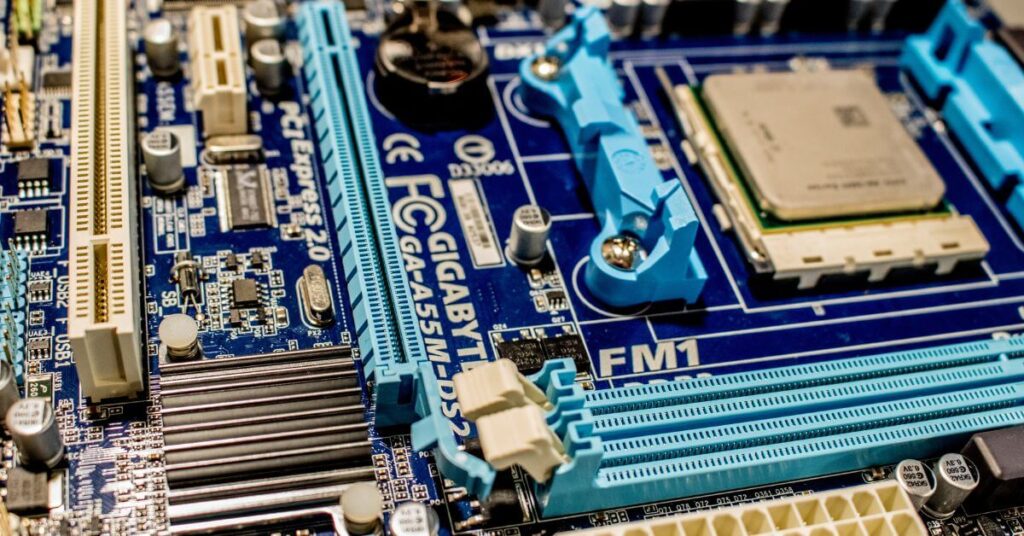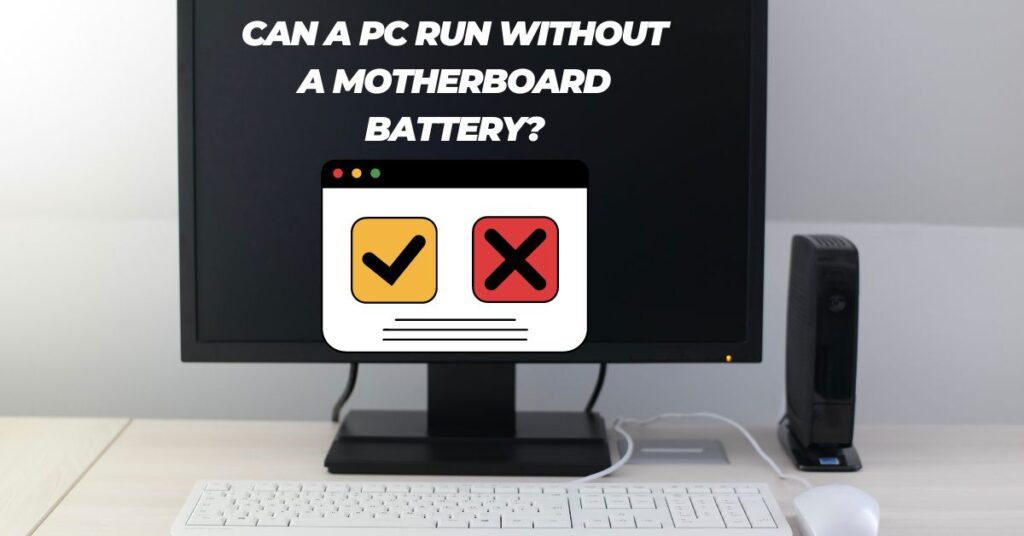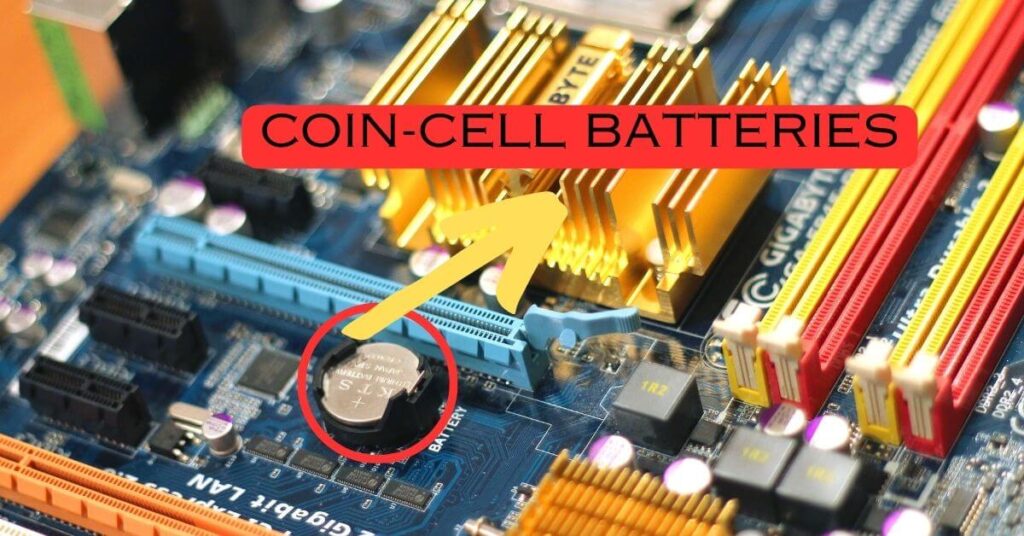The motherboard, a crucial component within a computer, is the central hub connecting various hardware components. While its primary function is to facilitate communication between these elements, the presence of a small battery on the motherboard serves a vital purpose. This battery, often a coin-cell battery, provides a stable source of power to maintain essential system settings and configurations when the computer is powered off.
Critical information, such as the system clock and BIOS settings, relies on the motherboard battery to retain data, ensuring a seamless startup and consistent performance each time the computer is turned on. The significance of “Why motherboard has a battery” lies in preserving these critical settings and ensuring the system’s reliability.
Table of Contents

Why the motherboard needs a battery?
The main reason a computer’s motherboard needs a battery is so that it can hold onto important system data and configurations when the machine is turned off. This battery, also known as the complementary metal-oxide-semiconductor (CMOS) battery, is essential to preserving the integrity of the configuration of the system.
Below are the main explanations for why a motherboard requires a battery:
- CMOS Memory Power:
- The CMOS battery provides power to the CMOS memory chip on the motherboard. This memory chip stores the BIOS (Basic Input/Output System) settings, including details like system date and time, hardware configuration, and other essential parameters.
- Real-Time Clock (RTC):
- The battery helps power the Real-Time Clock (RTC) that keeps track of the current date and time even when the computer is turned off. This information is crucial for various system functions, file timestamps, and scheduling tasks.
- BIOS/UEFI Settings:
- When you enter the BIOS/UEFI setup of a computer, you can configure various settings related to hardware and system behavior. The CMOS battery ensures that these settings are retained even if the computer is shut down or disconnected from power.
- Boot Order and Device Configuration:
- The motherboard’s BIOS/UEFI also stores information about the boot order and configuration of connected devices, such as hard drives and optical drives. The CMOS battery preserves these settings, allowing the system to boot up with the correct configuration every time it is powered on.
- Password and Security Information:
- Some systems use the CMOS memory to store password information and other security-related settings. This helps maintain the security of the system by preserving these details even during power-off situations.
- Stability and Consistency:
- Without a CMOS battery, the motherboard would lose all its configuration settings every time the power is turned off. This would result in the system reverting to default settings upon each boot, leading to instability and potential issues in the functioning of the computer.
Can a PC run without a motherboard battery?
Yes, a PC can technically run without a motherboard battery, but certain functionalities may be affected. The motherboard battery, typically a coin cell battery, is primarily responsible for preserving crucial system information and settings when the computer is powered off.

Here’s what you can expect if a PC operates without a motherboard battery:
- Loss of BIOS/UEFI Settings:
- The most noticeable impact is the loss of BIOS/UEFI settings every time the computer is turned off. This includes settings such as system date and time, boot order, and hardware configuration. The system will revert to default settings upon each boot.
- Real-Time Clock (RTC) Issues:
- Without the battery, the Real-Time Clock (RTC) won’t have a power source, causing the system to lose track of the current date and time when the computer is turned off. This can lead to issues with file timestamps and scheduled tasks.
- Potential Boot Problems:
- Changes in the BIOS/UEFI settings, such as the boot order, may cause boot problems or prevent the system from recognizing certain hardware components properly.
- Password and Security Issues:
- Systems that use the CMOS memory to store passwords and security information may experience authentication issues or require reconfiguration each time the computer is powered on.
- Inconvenience During Power Outages:
- In regions with frequent power outages, a motherboard battery helps maintain the system’s configuration during brief power interruptions. Without a battery, the system would lose its settings every time there is a power loss.
While a PC can technically function without a motherboard battery, it is generally recommended to have a functional battery in place for a smoother and more consistent user experience.
Can You Use Any Motherboard For Gaming?
Read this helpful article on your computer as well.
Why do motherboards still have a battery?
For several crucial reasons, motherboards still use batteries—usually coin-cell batteries. Maintaining vital system configurations when the computer is powered down is one of its main goals. Important data, including the BIOS settings, configuration information, and the system clock, are preserved thanks to the battery. These settings would be reset with each shutdown if this power source wasn’t present, which might cause annoyances and disturbances when the system was restarting.
The motherboard’s Real-Time Clock (RTC) feature, which enables precise timekeeping even when the computer is off, is another feature that the battery supports. To put it briefly, using a motherboard battery consistently is necessary to keep the system stable and to preserve important data.
How do I check my motherboard battery?
Checking your motherboard battery is a relatively simple process. The battery is usually a coin cell battery, commonly a CR2032, and it’s located on the motherboard.

Here’s a step-by-step guide on how to check your motherboard battery:
Steps to Check the Motherboard Battery:
- Power Off the Computer:
- Shut down your computer and turn off the power supply. Ensure that the computer is completely powered down and unplugged.
- Locate the Motherboard Battery:
- Open the computer case and locate the motherboard. The battery is usually a coin cell placed in a holder on the motherboard. It’s often silver or black and looks like a coin.
- Identify the Battery Type:
- Take note of the battery type. Most motherboard batteries are CR2032 lithium coin cells, but there might be other types. The battery type is usually labeled on the battery itself.
- Visually Inspect the Battery:
- Check the condition of the battery. Look for any signs of leakage or damage. If the battery appears swollen or has a powdery substance around it, it may be a sign that it needs to be replaced.
- Use a Multimeter (Optional):
- If you have a multimeter, you can use it to measure the voltage of the battery. Set the multimeter to the DC voltage setting and touch the positive (red) lead to the positive side of the battery and the negative (black) lead to the negative side. A healthy CR2032 battery typically reads around 3 volts or slightly higher.
- Check BIOS/UEFI Settings:
- Boot up the computer and enter the BIOS/UEFI settings. Look for a section that displays information about the motherboard battery. Some BIOS/UEFI interfaces provide information on the battery’s status and voltage.
- Observe System Behavior:
- Pay attention to any issues related to system time, date, or settings. If you consistently experience problems with the system forgetting settings or the clock resetting, it may indicate a weak or dead battery.
Signs that the Motherboard Battery Needs Replacement:
- Low Voltage Reading: If the multimeter reading is significantly below the expected voltage for a healthy battery.
- Visible Damage: Any signs of leakage, swelling, or other physical damage to the battery.
- Consistent BIOS/UEFI Issues: If you repeatedly encounter problems with BIOS/UEFI settings being reset.
How TO Connect Case Fans To The Motherboard?
Read this helpful article on your computer as well.
How long is the battery life of a PC motherboard?

Coin-cell batteries, which power PC motherboards, have varying lifespans, but they usually last 3 to 10 years. The quality of the battery, usage habits, and ambient conditions are some of the variables that affect how long it lasts. When the computer is turned off, these batteries are mainly in charge of keeping the real-time clock and system settings intact.
Their voltage drops with age, which could result in problems like time errors or BIOS resets. Even though many users might not need to replace the motherboard battery throughout their computer’s lifetime, issues like frequent time resets may point to the necessity of doing so, which is usually a simple and affordable fix.
What happens if the CMOS battery dies
If the CMOS (Complementary Metal-Oxide-Semiconductor) battery on a computer’s motherboard dies, several consequences may occur, impacting the system’s functionality and stability. Here are the key effects of a dead CMOS battery:
Here are the key effects of a dead CMOS battery:
- Loss of BIOS/UEFI Settings:
- The most noticeable impact is the loss of BIOS/UEFI settings. This includes system date and time, boot order, and hardware configuration. The system will revert to default settings every time the computer is powered on, leading to potential boot problems and changes in system behavior.
- Real-Time Clock (RTC) Issues:
- The CMOS battery powers the Real-Time Clock (RTC), which keeps track of the current date and time. When the battery dies, the RTC loses power, causing the system to lose track of time when the computer is turned off. This can lead to issues with file timestamps and scheduled tasks.
- Authentication and Security Issues:
- Some systems use the CMOS memory to store passwords and security information. If the battery dies, the system may have difficulty authenticating users, and security-related settings may be lost or require reconfiguration.
- Inconvenience During Power Loss:
- In regions with frequent power outages, a functional CMOS battery helps maintain system configuration during brief power interruptions. Without a working battery, the system would lose its settings every time there is a power loss.
- Unexpected Behavior:
- A dead CMOS battery can lead to unexpected behavior in the computer. It may fail to recognize certain hardware components properly, and the default settings might not be optimal for the system’s performance.
- Difficulty in System Diagnosis:
- When troubleshooting computer issues, having stable and consistent BIOS/UEFI settings is crucial. A dead CMOS battery can complicate the diagnostic process by introducing variability in system behavior.
- CMOS Checksum Error:
- Some systems may display a CMOS checksum error during the boot process if the CMOS data becomes corrupted due to a weak or dead battery. This error indicates that the data stored in the CMOS memory does not match the expected values.
- Difficulty in Updating the BIOS/UEFI:
- Updating the BIOS/UEFI may require a functional CMOS battery. If the battery is dead, the update process may be more challenging, and some motherboards may even require a working battery to complete the update successfully.
It is recommended to replace a weak or dead CMOS battery with a new one to resolve these problems. By performing this easy maintenance, you can make sure that the motherboard saves important data and configurations, resulting in a more reliable and consistent computing experience.
Final thought
Finally, a motherboard’s battery is an essential component for maintaining important system data and guaranteeing smooth operation. When the computer is turned off, this tiny but crucial part—typically a coin-cell battery—maintains the configuration data, the real-time clock, and the BIOS settings.
The motherboard battery ensures that users experience reliable system configurations, accurate timekeeping, and consistent startup procedures by offering a steady power source. This long-lasting characteristic highlights the significance of a seemingly insignificant part in the complex architecture of contemporary computing and demonstrates the dedication to maintaining the dependability and performance of computer systems.
Frequently Ask Question
Can a motherboard work without a battery?
While a computer can technically function without a motherboard battery, it would result in the loss of crucial settings and configurations every time the system is powered off.
How do I know if my motherboard battery is failing?
Signs of a failing motherboard battery include frequent BIOS setting resets, incorrect system time, and potential hardware recognition issues. If you notice these issues, it may be time to replace the battery.
Is replacing a motherboard battery difficult?
No, replacing a motherboard battery is a straightforward process. It typically involves removing the old battery and inserting a new one. However, users should exercise caution and follow manufacturer guidelines.
Can a dead motherboard battery cause data loss?
The motherboard battery is not directly responsible for data storage, so its failure typically doesn’t cause data loss. However, it can impact system settings and configurations.
What type of battery does a motherboard use?
Motherboards commonly use coin-cell batteries, such as CR2032. These batteries are compact and provide a stable power source for maintaining system settings.
Is it necessary to replace the motherboard battery proactively?
Generally, there’s no need to replace the motherboard battery proactively. However, if you encounter issues like frequent BIOS resets or time inaccuracies, replacing the battery is a recommended solution.
Can a motherboard battery be recycled?
Yes, motherboard batteries can be recycled. It’s important to dispose of them properly at recycling centers or follow local regulations for electronic waste disposal.
